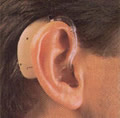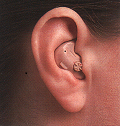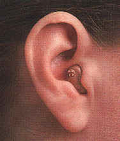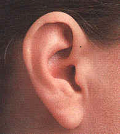Types of Hearing Aids
Behind the Ear (BTE) Hearing Aid

This style hearing aid has enough power to correct moderate to severe hearing loss. It is easier to keep clean, and the controls are large enough to manipulate easily. Some people shy away from this style due to its larger size, but it is available in different colors and mini sizes, which can make it less noticeable. These models tend to have a longer life because all of the electronic components rest outside of the ear and are not directly exposed to earwax and perspiration.
In the Ear (ITE) Hearing Aid

This style is more compact but not as small as some canal hearing aids. Remember, the very tiny hearing aids (shown below) can limit the amount of functions that are available to the user. The ITE may have a telecoil switch that enables one to hear on the telephone without feedback (whistling). A situation switch may also be used to reduce background noise when the environment is noisy. This style is appropriate for many types of hearing loss and can be used with one that has mild or severe hearing impairment.
In the Canal (ITC) Hearing Aid

This style fits inside the ear canal but can still be seen. This model may have a volume control that is small and difficult to use if the user has poor finger dexterity. It is a popular choice because of its relatively small size and ability to hold a dual microphone system (good for background noise control). This model is reserved for mild to moderate hearing losses.
Completely in the Canal Hearing Aid

This model is very popular for its small, cosmetic appeal. It is seated deeply into the canal, and it is also easier to use a telephone without feedback (whistling). Some of the drawbacks are that it can be more expensive and prone to causing occlusion effect (user's own voice sounds too loud). This style is reserved for those with mild to moderate hearing loss.
Digital Hearing Aids
How does a digital hearing aid work? How does the sound get processed so I can hear it? Inside the hearing aid, there is a tiny computer that processes sound a million times per second. This has an obvious advantage over the old analog technology that acts primarily as a straight amplifier (just made things louder). The only hearing aids that were available 10-15 years ago were analog. The digital aid (today's technology) can separate speech from background noise, providing a cleaner sound and are programmed for the user's specific hearing loss and can also offer multiple programs to use in different listening situations. A typical cost for a digital aid is $1000 to $3000 each.
Digital is not for everyone. Many factors must be weighed when choosing a hearing aid, including the type of hearing loss, as well as finances. Your hearing professional should work with you to find the most appropriate type of amplification that will work with your lifestyle and budget.
Why are hearing aids so expensive?
This is a question that is often asked at our clinic. There are a few reasons for the cost of hearing aids. The cost of a hearing aid shell and circuit is very low, except when you consider the following:
Hearing aids are sold in relatively low volume as opposed to other electronic equipment (i.e., televisions, DVD players, stereos). This means that it is expensive to produce hearing aids because there is a low demand.
Manufacturers spend millions of dollars on research and development every year. Research and development results in improvements in product size, quality, and performance, but does cost manufacturers money that gets passed on to the consumer.
Audiologists spend many hours of time assisting customers in programming, doing repairs, and cleaning hearing aids during the life of a hearing aid. While it is true that mail order hearing aids can be bought at a lower price initially, those hearing aid purchases are without the support and assistance of audiologists and often lack maintenance services that are needed for hearing aids to perform as intended. Patients who order hearing aids through the mail are often stuck with the additional charges for office visits or maintenance fees when the hearing aid needs re-programmed or serviced.